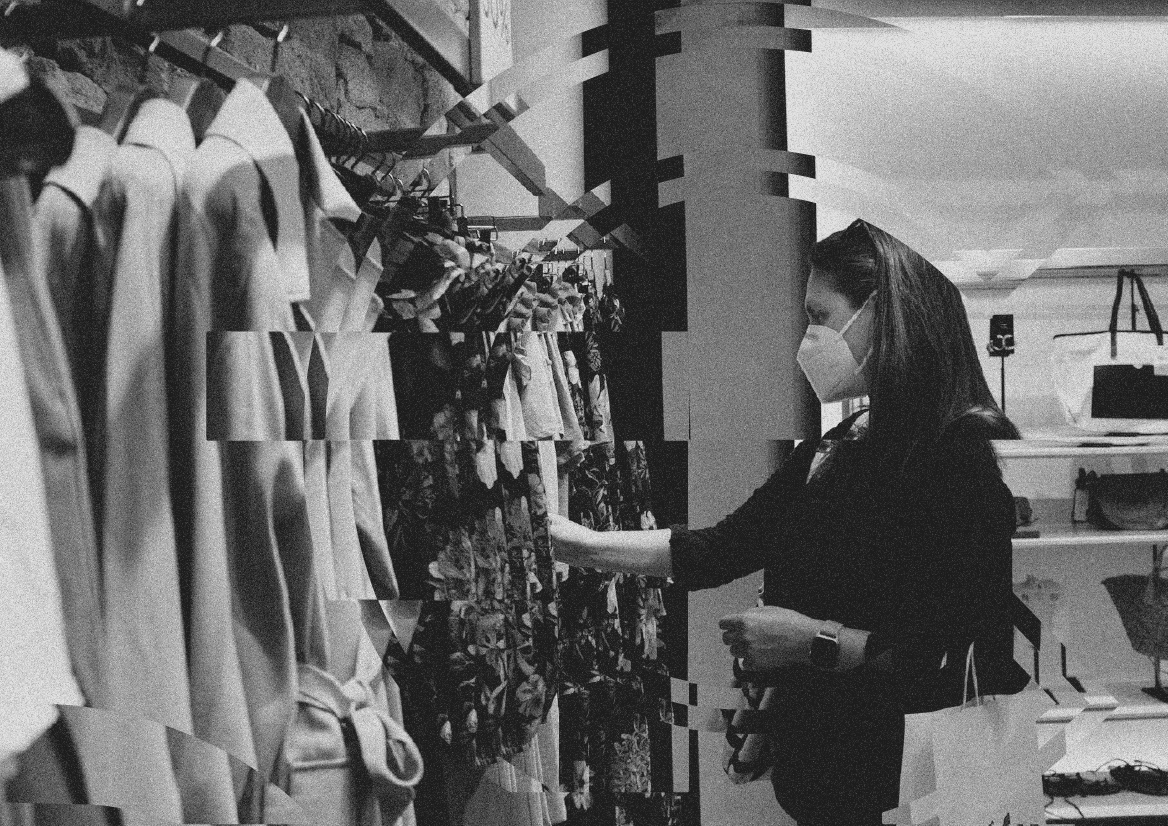
On Lebaran and Escaping the Bottomless Cycle of Consumerism
In this Open Column submission, Teuku Reza Fadeli explores the complex interplay between religious observance and consumerist pressures during Lebaran in Indonesia.
Words by Whiteboard Journal
Forget the prayers, family visits, and the undeniable proof that holiday had arrived for a second. Lebaran in my Jakarta childhood was all about the new baju crammed into bursting shopping bags, and relentless mall soundtracks promising me I’d look the part if I just bought one more thing.
These days, add in the endless online scrolling and that notification ping of another order. Growing up in a Muslim family meant certain rituals were non-negotiable, but this relentless pressure to keep up with the latest fashion was alongside those familiar rhythms. I still remember the pang of envy seeing someone at Lebaran prayers sporting the latest sneakers, knowing there was no way my parents would buy them. No one talks about how a holiday meant for forgiveness and reflection turned into a fashion show driven by easy spending. But that uncomfortable truth—about Lebaran, about Indonesia, about all of us—is where the real story lies.
This consumer frenzy has deep roots. Borrowing a line from a Singaporean sociologist, Beng-Chua Huat, “Life is not complete without shopping.” Lebaran often feels the same. It’s not that you won’t literally get turned away from the feast if you don’t have that new outfit, but the unspoken expectation is there. I’ve seen more tears over ill-fitting dresses than heartfelt prayers at Eid. Even as a child, I felt the pressure. The song “Baju Baru Alhamdulillah” might be cheerful, but its constant refrain on the radio only added to the sense that a perfect outfit was the key to a perfect Lebaran. Remember those special “THR” envelopes? Supposed to be holiday bonuses, for many families, that cash vanished fast.
I remember my aunt, a kind woman, snapping at a shopkeeper because the lace he sold her turned out scratchy, not the soft one advertised. She was stressed, trying to make her family’s Lebaran perfect, and the pressure got to her. This pressure isn’t uniquely Indonesian. Companies everywhere turn celebrations into shopping frenzies. But why? For that, blame the usual suspects: colonialism, capitalism, and the obsession with ‘being modern’.
Colonialism kick-started this in Indonesia. The expansion of colonial bureaucracies and trade networks powered the rise of a new middle class: educated locals, prosperous merchants, and those finding opportunities within the colonial system (Sutherland, 1979). This group was uniquely positioned between Western dominance and local traditions. For them, emulating European lifestyles wasn’t just about desiring nice things. It was about claiming a place in a changing world, signalling their education, sophistication, and perhaps even a form of subtle resistance.
Consumerism became the new measure of ‘modernity’. Before, ads might have focused on a product’s quality or use. But as colonialism tightened its grip in the 1920s, a new kind of advertising emerged (Hoogervorst & Nordholt, 2017). Filled with images of European homes, fashions, and leisure pursuits, these ads promised that acquiring the right possessions would grant access to a ‘modern lifestyle’. This wasn’t just selling you goods; it was selling an identity inseparable from consumption.
However, it would be simplistic to see this solely as passive imitation. This emerging middle class used consumer choices in complex ways. Adopting certain Western fashions might be about professional advancement, while a carefully chosen traditional textile spoke to their cultural pride. It was a constant negotiation—what to embrace, what to resist—that shaped personal lives and the very idea of what it meant to be “modern” in a colonised Southeast Asia.
While the unique forces of colonialism shaped this historical negotiation, the core tension remains strikingly similar today. Ads bombard us with the ‘perfect’ Lebaran look, the must-have foods, and the gifts that supposedly show we care. It’s relentless—this idea that we need to buy our way to a meaningful celebration. We’ve been tricked into thinking that a full shopping cart, not a full heart, is what makes us special.
This drive to consume has become so intertwined with Ramadan that it’s now termed “Sacred Commerce.” In fact, the latest report from Moonfolks’ Ramadan Whitepaper (2024) reveals a 92% increase in transactions through TikTok sellers during Ramadan compared to previous periods. This highlights a shift where brands strategically tap into the desire for both celebration and spirituality.
Those early colonial ads? They were the ones guilty of planting that trick. They sold the idea that being modern and truly successful means owning the right things. Now, they’re using influencers and targeted pop-ups for slicker selling methods, but the message is still the same. A sad yet very human expression of how deeply colonialism’s consumerist vision warped our traditions.
Of course, this isn’t just about Lebaran. The legacy of this warped vision extends far beyond any single holiday. For example, a 1934 article in the Pinang Gazette and Straits Chronicle, titled “Festival Shopping,” boasts about a “surge in economic activity” driven by purchases of “cloth, jewellery, sweetmeats, and other luxuries.” The article even uses the phrase “money circulating freely” to highlight the commercial aspect of the holiday. This focus on spending starkly contrasts the religious and cultural significance of Eid al-Fitr, Christmas, Chinese New Year, or Diwali. This reveals how even the most diverse festivals became opportunities to drive consumption, regardless of their origins.
This commercialization of celebrations has only intensified as consumerism has become a defining feature of modernity. Some scholars see it as filling the existential emptiness created when traditional structures weaken. Others, like sociologist George Ritzer, see it taking on an almost colonising force. His concept of “McDonaldization” shows how values of efficiency and standardisation push into areas beyond fast food, influencing how we think about everything from healthcare to holidays like Lebaran.
But Lebaran’s transformation also has a uniquely Indonesian element: resistance. This drive to consume didn’t simply erase tradition; it sparked a complex negotiation between modernity and tradition. We see this in the middle class who used consumerism to claim agency and status, even within a colonial system.
This tension plays out in Marco Kartodikromo’s novel, Student Hidjo. The protagonist, Hidjo, sent to study in the Netherlands, embodies the seductive yet alienating power of the ‘modern’. He starts to yearn for Western clothes and possessions, even as he experiences racism and a sense of displacement. This isn’t just about wanting nice things – as Kartodikromo writes, “Material possessions were the visible symbols of being modern.” Even as he critiques colonial forces, Kartodikromo shows how tempting that consumerist promise could be.
Student Hidjo is an act of resistance in its telling, as the author was imprisoned by colonial authorities when he wrote it (Maier, 1996). The novel suggests that the new Indonesian identity will involve navigating these forces: the lure of the ‘modern’ versus the pull of tradition, the desire for acceptance versus the fight for self-determination.
This mix of consumption and resistance mirrors the larger story of Lebaran. Secularization, while influenced by colonialism, isn’t just a top-down force. It’s what we do with these forces—how we shop, what we value—that will determine if Lebaran is ultimately a celebration of faith or of fashion. This constant negotiation mirrors Hidjo’s own struggle, revealing a tension that extends far beyond one individual’s journey or a single holiday.
One positive trend is the rise of conscious consumerism. More people are making deliberate choices, supporting fair trade, sustainable practices, and ethical brands. This movement, if it can take hold in Indonesia too, shows that ‘modernity’ doesn’t have to mean mindless spending. It can mean using our economic power to reclaim something Lebaran is meant to be about: generosity.
This potential shift in how we think about consumption resonates even with critical theorists who see consumerism as deeply ingrained in our societies. While Karl Marx focused on the worker and the means of production, his concept of how objects can take on power beyond their use-value is relevant here. Choosing ethically made goods or giving donations instead of buying more things for ourselves could be a way to reclaim some of that power, resisting the idea that our worth is determined by our possessions. Jean Baudrillard might argue that such efforts challenge the very notion of consumerism filling an existential void, as they prioritize values other than acquisition. Zygmunt Bauman would likely see it as a potential way to forge identities that aren’t solely defined by what we own but by the choices we make and the communities we support. Thus, #FreePalestine!
This isn’t some return to an imagined past. Lebaran has always been a blend of tradition and the contemporary. But we need to choose what that blend looks like. Will it be dictated by the latest ad campaign, or by the true meaning of Eid al-Fitr? That choice, made individually and as a society, is how we write the next era of this beloved celebration.
The stakes, however, reach far beyond Lebaran. As Aja Barber reminds us, the environmental impact of our consumption choices is a stark reminder that unchecked consumerism is a global problem. The pressure to buy new clothes for Lebaran echoes tactics used by neo-colonial forces, promoting a singular vision of ‘modernity’ tied to excessive consumption. By consciously choosing how we celebrate, we resist not only these external pressures, but also the destructive forces within consumer culture itself.











